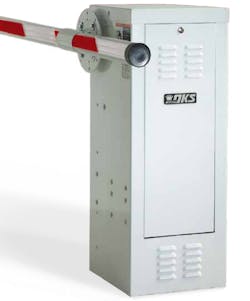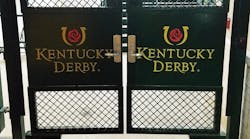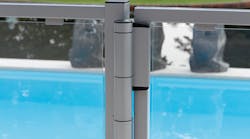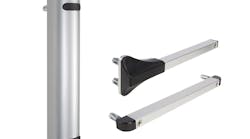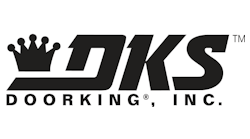Gate operator work can be a profitable and interesting sideline for almost any locksmith looking for new revenue sources. We used to bid new ones and also provided upgrades and support for existing systems. I can recall installing numerous gate arm operators for projects that were used for parking control applications. And while many locksmiths may be familiar with door and gate operators, receiving formal training in many cases, the best experience is learning from seasoned installation technicians.
Certification
Just like there is an The American Association of Automatic Door Manufacturers (AAADM), that provides technical resource and installer training and certification for door operators, there is also the American Fence Association (AFA), which offers resources and a training certification program for Automated Gate Operator system designers and installers.
A coalition of industry leaders from the International Door Association, the Door and Access Systems Manufacturers Association and the National Ornamental and Miscellaneous Metals Association have joined the AFA for certification programs that are administered by the Institute of Door Dealer Education and Accreditation (IDEA) and the Automated Gate Systems. For more information go to their website: http://www.americanfenceassociation.com .
A Gate Primer
While some security projects that involve an electrician might require a license, installing gates usually does not. However, locksmiths must check to confirm what might be required for their particular locality and look to sub out portions of the work if licensing is indeed mandated. [SL1]
The standard to which vehicular gate operators are designed, manufactured and tested is UL 325; Underwriters Laboratories Inc., Standard for Safety: Door, Drapery, Gate, Louver, and Window Operators and Systems. In addition to the 325 standard, vehicular gate operators must also be tested to UL 991; Tests for Safety-Related Controls Employing Solid-State Devices.
The UL 325 Standard has undergone significant revisions over the past several years. The purpose of the revisions is to create entrapment prevention criteria for vehicular gate operators and systems, and to increase over-all safety of the product.
The standard also calls out for specific construction specifications for the vehicular gate itself.
ASTM F2200 is an important document covering specifics of gates, and an excellent explanation can be found at the Door & Access Systems Manufacturers Association website: http://www.dasma.com/pdf/publications/techdatasheets/operatorelectronics/tds370.pdf
In the late 1990s the U.S. Consumer Product Safety Commission (CPSC) documented several deaths and injuries attributed to entrapment accidents involving automatically operated gates. This included a number of tragic incidents involving children playing on automatic gates that did not include sensing devices or reversing mechanisms to prevent the entrapment.
To address these hazards, CPSC worked with UL and other stakeholders to develop product safety requirements to reduce these risks, which were incorporated in the March 2000 edition of the UL 325, the Standard for Safety for Door, Drapery, Gate, Louver, and Window Operators and Systems. This covers gates that are intended to control vehicular entrance and/or egress.
Know Your Gate
Vehicular gates may be swinging or sliding type. Barrier arm operators are also considered a form of gate that controls a cantilever type device (or system), consisting of a mechanical arm or barrier that moves in a vertical arc, intended for vehicular traffic flow at entrances or exits to areas such as parking garages, lots or toll areas.
Vehicular gate operators are required to have provisions for, or be supplied with, at least one independent primary and one independent secondary means to protect against entrapment.
Entrapment protection is not required for barrier arm operators that are not intended to move closer than two feet from a rigid object, provided they do not have pinch points between moving parts.
UL 325 includes specific requirements for vehicular gate operators based on their intended usage, as defined by one of the following four classifications: An ever-increasing number of commercial and residential facilities are installing motorized gates and barriers to enhance physical security. Like any outdoor installation of motorized equipment, there are electrical safety considerations that need to be addressed. In addition, the very nature of motor driven electrical gates and barriers presents unique personal injury hazards. It is important for code authorities and installers to understand how these systems are to be selected, configured and installed to provide safe, code compliant installations.
The various types of gates and operators include:
- Class I – Those intended for use in a home of one-to four single family dwelling, or a garage or parking area associated therewith.
- Class II – Those intended for use in a commercial location or building such as a multi-family housing unit (five or more single family units), hotel, garage, retail store, or other building servicing the general public.
- Class III – Those intended for use in an industrial location or building such as a factory or loading dock area or other locations not intended to service the general public.
- Class IV – Those intended for use in a guarded industrial location or building such as an airport security area or other restricted access locations not servicing the general public, in which unauthorized access is prevented via supervision by security personnel. The types of required primary and secondary entrapment protection vary, depending on the gate classification, and its intended movement. This protection can include the following methods, among other protection criteria:
Inherent entrapment protection system that stops and reverses the gate within 2 seconds.
A non-contact photoelectric sensor or the equivalent that stops or reverses the gate within 2 seconds.
A contact sensor (edge device or the equivalent) that stops and reverses the gate within 2 seconds.
An inherent adjustable clutch or pressure relief device that, upon sensing an obstruction in any direction, will stop the gate and not result in a closing force more than 10 percent higher than the initial setting required to stop the gate, which cannot exceed 40 lbf.
An actuating device requiring continuous pressure to maintain opening or closing motion of the gate. Upon removal of pressure, movement of the gate must cease.
An audio alarms.
Understanding UL Certifications
Gate operators are certified (Listed) under the Door, Drapery, Gate, Louver, and Window Operators and Systems product category (FDDR) found in the Online Certifications Directory at www.ul.com/database.
This category covers electrical and pneumatic door and gate systems, and door, drapery, gate, louver, window and turnstile operators, together with controls and accessories for use with such operators, and similar devices.
They are also marked to specify all intended use Classes, along with their maximum rated closing force.
Certified vehicular gate operators include a UL Listing Mark, the word LISTED and “Gate Operator” or other appropriate product name as shown in the individual Listings.
They are also marked to specify all intended Classes of applications, along with their maximum rated closing force. Installation considerations Installers and code authorities need to be aware that the ultimate safety of the system is dependent upon proper installation.
Particular attention needs to be given to the following:
1. Code authorities should be consulted prior to installation.
2. Verifying that the gate operator Class is appropriate for the intended installation.
3. Installation should be performed by a qualified installer using the manufacturer’s instructions.
4. Special care should be exercised during installation to ensure that recommended safety devices, such as photoelectric sensors or reversing-edge switches, are properly installed.
BEA LZR-H100 and LZR-H10
This sensor is designed to be used as a movement and presence sensor to control the opening and the closing process of a gate or a barrier. The installer of the system is responsible for installing the sensor and the system in compliance with applicable national and international standards on safety. The manufacturer of the sensor cannot be held responsible for incorrect installations or inappropriate adjustments of the sensor.
This device is not intended for use in with any automatically activated doors. U.S. Pat. No. 7,084,388, which is not owned by BEA, covers automatic doors comprising, among other things, a scanning detector. The LZR-H100 is not sold with consent, implied or otherwise, for use with automatically activated doors, as set forth in the patent.
BEA’s LZR-H100 is a laser-based time-of-flight sensor designed for gate and barrier applications.
This solution provides four laser-based curtains, offering a three-dimensional detection zone for accurate object detection. Its detection curtains are highly configurable and can be set up for activation and presence detection in vehicle sensing applications.
The LZR-H100 is an effective alternative to induction loops and is housed in a NEMA 4 rated enclosure, further ensuring its performance in outdoor environments.
The features and benefits of the Laser Scanner for gate and barrier applications include:
• Two relays allow for activation via motion or presence
• Ideal for applications where cutting ground for loops is prohibited, impossible or expensive
• Time-of-Flight presence-based opto-electronic sensor ensures accurate and immediate detection
• Ability to detect vehicle trajectory during approach and departure
• Ability to detect or ignore pedestrian traffic
• Maximum detection field of 9.6 m × 9.6 m (32 ft × 32 ft)
• Teach-in setup via walk path or remote-control configuration
BEA Q&A
Locksmith Ledger asked BEA product specialists to share some information related to their new sensor. Here is what they shared.
What features make the LZR-H100 unique and better than competitor's products? Who makes a product that competes with the LZR-H100?
BEA makes the LZR-H100 which builds two unique patterns that covers an area that you program on site. It will protect cars, trucks, motorcycles and people traffic in each area or pattern. This product works on any brand gate operator, barrier gate operator, vertical lift gate or pivot gate operator. Each field can be programmed up to 32 feet by 32 feet.
Each pattern is programmed individually, or they can be the exact same size. This product incorporates two relays. Relay one is for a free exit input. Relay two is used as either a safety pattern or a shadow loop pattern. A shadow loop is used under a swing gate. This is also sometimes called a center loop. This product works on an uphill driveway, downhill driveway or curved driveway. It is used to replace a loop field with wiring that is installed into a sawcut in the pavement or asphalt. Unlike a loop field, we can install this within a ½ inch of a moving gate.
No other product in our industry today will adjust to the size of these fields as well as having built in protection for people. Photo eyes, loop detectors or edges require someone to either be hit by the gate or have minimum protection in one small area.
The LZR-H100 uses a LASER that is at 905nm. That is the frequency used. It is something that is not affected by anything coming off the sun, out of the atmosphere or anywhere on earth. Therefore, it is not affected by cell towers, overhead power lines or other electrical devices that cause problems with most electronics. When programming this device, you activate a lower frequency LASER that you can see, which is used to align the sensor with the gate and allow you to check how far the LASER is off the ground.
Vehicle loop detectors have problems with damaged asphalt, broken concrete or concrete that can’t be cut because it is pre-tensioned concrete. Loop detectors will have issues with cold climates due to water penetrating the saw cut and then freezing and allowing water and ice to sit in the saw cut of the loop. Without regular maintenance, the loop will start to fail. Loops have a detection field coming up from the ground about 2/3rds the size of the shortest leg of the loop. The LZR-H100 can be mounted at a height that is based on the site and type of vehicles using the driveway.
The LZR-H100 works great on trucking yards and will see big rigs, their trailers and cars plus people. The pattern from the LZR-H100 has a taller pattern, the further you get away from the sensor. This allows the LZR-H100 to see trailers and other objects sometimes missed by loop detectors. You can stand 30 feet from the LZR-H100 and hold a screwdriver in the field, and it will see just the shaft of the screwdriver. It is that accurate.
What is a "Barrier"
A barrier gate operator is basically a motorized vertical box with an arm that goes up and down. The barrier gate operator is similar to an automatic gate operator, but the output shaft only turns an arm from the full open upward position to closed which is the downward position. Barrier gate operators are sometimes used with other equipment which regulate entering and exiting as well as with anti-crash products that keep people from running through a barrier arm. They are also used to curtail tailgating through a gated entrance. When installing our LZR-H100 on barriers, you can adjust the fields to align with any islands where the barrier is mounted and extend under the arm, so you have protection from people walking under or near the arm.
Again, no other product will accomplish this.
What does "time-of-flight" mean?
LASER technology works according to the principle of time of flight. The sensor sends an intense light impulse in a defined direction and measures the time until the signal returns. As the speed of light is a constant value (approximately 186,000 miles per second), this time is directly proportional to the distance between the sensor and the first object encountered by the light impulse. As a result, and by sending multiple beams in multiple directions (2D or 3D), the sensor is capable of knowing the exact position of any object in its detection area at any given time. By analyzing this information over a very short period, it is easy to determine the shape, speed, and direction of any object.
How would the two relays be used for motion and presence?
Relay one is for motion or free exit is a pulsed signal but it can be also be programmed to be presence. When a vehicle enters this area, the LASER signals the operator that a vehicle has entered the field. It sends a signal and the gate or barrier would open. If it is closing and you enter the field, it would reverse and open.
The free exit pattern is adjustable so it will only see vehicles if you choose that option.
If you enter the field for relay two which is a presence signal, it sends a constant signal to make sure the gate opens and stays open. It will not open a gate if the gate is closed.
The Free exit input can also be filtered for directionality. So, you can see only traffic coming down the center or see traffic coming only on the right or only on the left.
Factory setting on the free exit is only seeing traffic exiting. You can also adjust that setting so it will see cars going both directions.
Is the sensor affected by smoke, dust clouds, ice, snow, insects crawling on it or wind?
This product is not affected by these. In extreme cases where you have 6 feet of snow and the sensor is mounted at 20 inches, you would need to blow off the snow if the sensor is buried. If you had a forest fire and you could not see your hand, it is possible the sensor would not work. We have options in our programming that allow the sensor to work in very extreme conditions by slowing down the sensor which allows gaps in fog, snow or really heavy rain to still be ignored and not have the sensor believe that these are objects in one of the fields.
Can the sensor be false triggered by adjacent electronic equipment?
No, nothing will set this off by accident.
Is a universal remote controller required to fully deploy this product?
Yes, we have a single programmer that works on any BEA sensor. This is purchased one time and kept by the installer.
Can this product be effectively used for any other applications (automatic doors, swing gate operators?)
We have other sensors for pedestrian doors that are less costly and would do the same job.
Swing gate installations are different than slide gate installations. On swing gate operators, you normally install the sensor at least 10-15 feet past the tip of the swing gate. Then you will typically build a field for a free exit and then a shadow field covering the gate when it is fully open. If you want a safety or interrupt field on the outside of the swing gate, you would mount the LZR-H100 next to the gate in the closed position and build a field up to 32 feet away for an outside safety.
DoorKing 1601
DoorKing®, Inc. (also known as DKS®) was established in 1948 and is one of the leading manufacturers of telephone entry systems, vehicular gate operators, parking control products and access control systems in the United States.
I’ve used their operators and telephone entry systems for decades and like them a lot.
DoorKing manufactures a complete line of residential, commercial, industrial and maximum-security vehicular slide and swing gate operators.
A while back I made a sales call, and won a project involving a ground up installation of a pair of DK 1601 barrier gates for a commercial operation which processed ‘yard waste’ into mulch. They referred to the finished product as pay dirt.
At the entry point to the site they had a permanent structure built for the facility management office and to house the computers, communication and control equipment. We supplied site diagrams describing the size and where the poured concrete pads had to be situated for the operators and pedestals, along with the requirements that conduit runs between each operator pad, each pedestal, and a location inside the building would be mounted. Our hardware included readers, keypads, a UPS, a PoE router, and door controllers for each gate (one entry and one egress).
We purchased all materials including the gate operators from ADI Distribution, and had direct communications with DoorKing Tech support for both details regarding the initial specification and quote, as well as tech support after the system was roughed in and we needed a little help with final adjustments.
The Model 1601 is for high usage single-lane vehicular traffic control. Typical applications include commercial, industrial, gated communities and apartment complexes. A quick 1.5 second rotation opening time, along with rugged construction and multiple optional features make this 1601 a versatile answer to many parking control problems. The 1601 is available in white or gun metal gray finish.
These operators are designed so that they can be mounted on either the left- or right-hand side of the roadway. A battery powered Convenience Open option is available, which provides a method to open the gate if AC power is lost.
Features Include:
- Magnetic limit control.
- Ports for plug-in loop detectors.
- Automatic sequencing inputs for use with slide and swing gate operators.
- Up input memory buffer.
- Down memory option.
- Multiple up commands.
- Two convenience outlets.
- 360° gear box rotation.
- Gate tracker reporting output.
- Programming switches.
- Built-in power On/Off switch.
- Left- or right-hand mount.
Specifications:
- 1/2 HP continuous-duty motor.
- 115, 230*, 460* VAC. (*230 and 460-volt units use a step-down power transformer to achieve 115-volt operating voltage.)
- 40:1 gearbox running in a continuous oil bath.
- Arm rotates 90° in approximately 1.5 seconds.
- Class II, III and IV applications.
- Compliant with UL 325 and 991. ETL Listed. (Note: To be compliant with UL 325 and industry safety guidelines, entrapment protection devices need to be installed with this gate operator.
- Dimensions (operator only): 15.25"W x 39.5"H x 14.75"D.
Options include 14-foot aluminum arms with Rev Edge and LEDs and 12-foot plastic arms
Camden Lazerpoint
Camden Lazerpoint RF represents the latest in wireless automatic door control technology.
Lazerpoint RF is a completely new wireless solution for automatic door operators. The system introduces the many advantages of 915MHz. spread spectrum wireless technology to the automatic door market.
The Lazerpoint RF TM System encompasses the widest range of transmitters, receivers, activation devices and switch enclosures available today. Lazerpoint RF receivers use daughterboards so they also support 300MHz., 390MHz., and 433MHz. transmitters.
Exclusive Features:
• 12 / 24V AC/DC operation means compatibility with every door operator.
• Convenient Terminal Strip means hassle free wiring (no dubious Marr connectors).
• 40 Code Memory accommodates larger installs.
• 1 – 30 second potentiometers are “user-friendly” (versus complicated dip switches).
• Instant ResponseTM Feature means even the briefest switch press insures reliable activation.
• 2 x dual function LED’s - Relay status, # of learned codes,
• Dual function LED bar graph – learned transmitter codes & Potentiometer VisualizerTM
• 1 or 2 Form C relays with 3 Amp contacts for dependable relay life.
• 33” LED Cable tool aids installer by duplicating on-board LED’s.
LOCINOX Mammoth
This patented product is an elegant and powerful self-closing hydraulic gate closer for 180° gate situations. The Mammoth is a real muscleman, perfectly fit for heavy gates up to 330 lbs. It is equipped with a double bearing for an extremely comfortable functionality. The Active Thermal System guarantees a constant closing speed, unaffected by weather conditions. The Dino hinge is included.
Features include:
- Self-closing 180° hinge with patented hydraulic damping
- Discreet and aesthetic look
- Powdercoated aluminum housing
- Constant closing speed in hot or cold weather
- Low opening resistance: max. 15 Nm (3-5 lbs)
- Vandal-proof
- For left- or right-turning gates
- Firmly fixed with the patented Quick-Fix mountings
A new accessory is the chain link bracket for Mammoth closers. Specifications:
